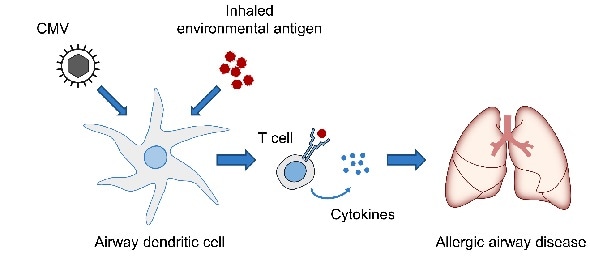Mar 8 2019
Cytomegalovirus (CMV) infection can convert a harmless, inhaled protein antigen into an allergen, according to a study published March 7 in the open-access journal PLOS Pathogens by Rafaela Holtappels from the University Medical Center of the Johannes Gutenberg-University Mainz, and colleagues. According to the authors, the findings suggest that CMV airway infection significantly enlarges the spectrum of potential environmental inducers of allergic airway disease.

"Airway co-exposure to cytomegalovirus and environmental antigen sensitizes for allergic airway disease. Credit: Lemmermann NAW and Reddehase MJ "
CMV infection of the fetus causes birth defects, and in immunocompromised patients, CMV infection of the lung can result in life-threatening pneumonia. Holtappels and colleagues add a novel aspect of how CMV can contribute to airway disease. Primary infection with CMV occurs in early childhood and involves the airway mucosa, where CMV and inhaled environmental allergens can meet. This medically relevant situation was studied experimentally by using a mouse model of airway co-exposure to CMV and ovalbumin -- a protein antigen with inherently low allergenic potential.
Ovalbumin exposure or CMV infection alone failed to sensitize for allergic airway disease. By contrast, airway infection with CMV at the time of ovalbumin sensitization predisposed for allergic airway disease. This effect was mediated by activation of airway dendritic cells. The results show that even a protein antigen that has low-to-no allergenic potential on its own can sensitize for allergic airway disease when CMV activates airway dendritic cells for more efficient antigen uptake. According to the authors, future research should focus on defining the conditions under which CMV airway infection could possibly contribute to the development of full-blown asthma.
The authors add:
CMV infection of the airways activates dendritic cells for a more efficient uptake of inhaled environmental antigens of otherwise low-to-no intrinsic allergenic potential. This mechanism sensitizes detrimental immune cells that can cause allergic airway disease after antigen re-exposure.”